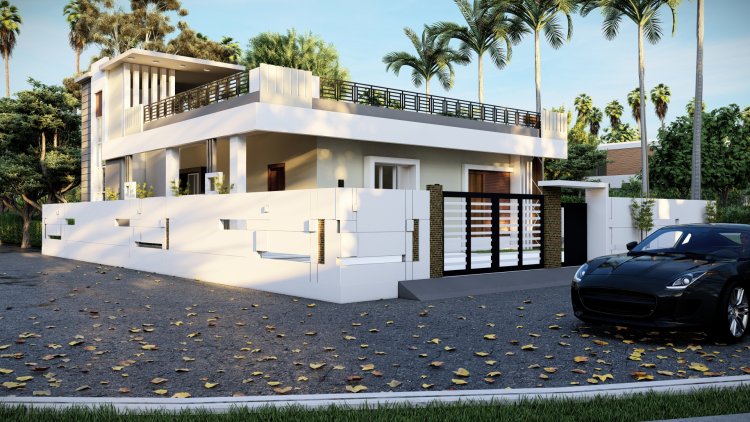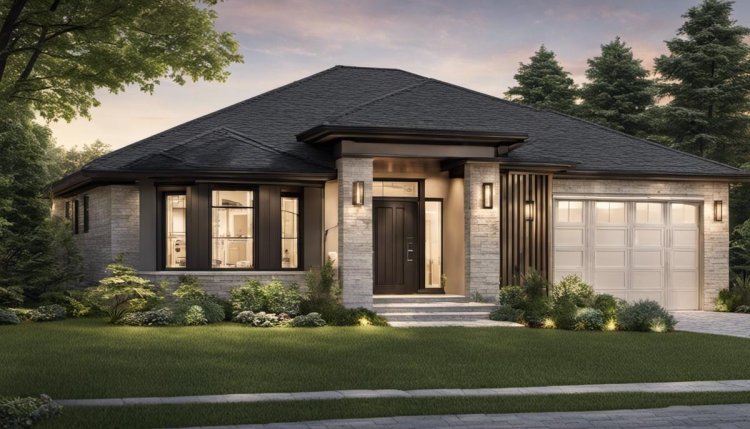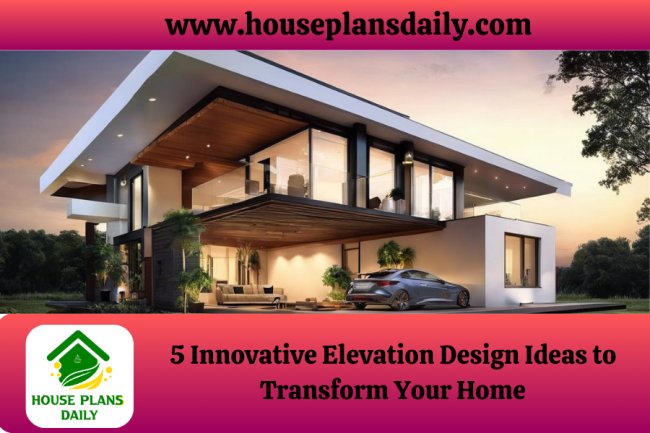Modern Elevation Design Ideas
Are you looking to give your home a fresh new look? Enhancing your home's curb appeal is a great way to make a lasting impression.
Enhance Your Home's Curb Appeal with Modern Elevation Design Ideas
Are you looking to give your home a fresh new look? Enhancing your home's curb appeal is a great way to make a lasting impression. With modern elevation design ideas, you can transform the exterior of your home and create a stylish and inviting atmosphere.
From sleek and minimalist designs to bold and eye-catching architecture, modern elevation design offers endless possibilities. By incorporating clean lines, innovative materials, and unique shapes, you can create a visually striking facade that stands out from the rest.
Whether you're planning a complete renovation or simply want to update your home's exterior, modern elevation design can make a significant difference. Not only will it boost your home's curb appeal, but it can also increase its value and make it more attractive to potential buyers.
In this article, we will explore various modern elevation design ideas that can elevate the appearance of your home. Discover the latest trends, innovative techniques, and expert tips that will help you achieve the perfect exterior look. Get ready to transform your home with modern elevation design ideas that will leave a lasting impression.

front design ideas
Importance of curb appeal
When it comes to your home's exterior, first impressions matter. Curb appeal plays a crucial role in creating a positive image of your property. A well-designed exterior not only enhances the aesthetic appeal but also reflects the overall quality and value of your home.
A visually appealing facade can make your home stand out in the neighborhood and create a sense of pride for homeowners. It sets the tone for the rest of the house, making it inviting and appealing to both residents and visitors. Moreover, a well-maintained and attractive exterior can significantly increase the value of your property.
Investing in modern elevation design is a smart choice for homeowners who want to enhance their home's curb appeal. It allows you to create a unique and personalized look that sets your home apart from others in the area. With the right design elements and techniques, you can transform your home's exterior into a work of art.
What is modern elevation design?
Modern elevation design refers to the architectural style that focuses on clean lines, simplicity, and innovative materials. It embraces minimalism and aims to create a visually striking facade that is both functional and aesthetically pleasing.
Unlike traditional architectural styles, modern elevation design emphasizes simplicity and avoids unnecessary ornamentation. It favors straight lines, geometric shapes, and open spaces. The use of innovative materials such as glass, metal, and concrete adds a contemporary touch to the overall design.
Modern elevation design is characterized by its sleek and minimalist appearance. It often features large windows, flat roofs, and open floor plans. The focus is on creating a harmonious balance between form and function while maximizing natural light and ventilation.
Elements of modern elevation design
To achieve a modern elevation design, several key elements need to be considered. These elements work together to create a cohesive and visually appealing exterior. Let's explore them in detail:
Incorporating Natural Materials in Your Home's Exterior
One of the defining features of modern elevation design is the use of natural materials. Incorporating materials such as wood, stone, or brick can add warmth and texture to your home's exterior. These materials create a sense of connection with nature and bring a timeless appeal to the overall design.
Wood siding can be used to add a touch of warmth and natural beauty to your home's exterior. It can be combined with other materials like glass or metal to create a modern yet inviting look. Stone or brick accents can be used to create focal points or add visual interest to the facade.
Minimalist and Clean Lines in Modern Elevation Design
Clean lines and simplicity are at the core of modern elevation design. The use of straight lines and geometric shapes creates a sense of order and balance. Horizontal lines can make your home appear wider, while vertical lines can make it look taller.
To achieve a minimalist look, avoid excessive ornamentation and clutter. Opt for simple and streamlined design elements. Use materials with a smooth and polished finish to create a sleek and contemporary appearance.

home front design elevation
Creating Focal Points with Architectural Features
Architectural features can be used to create focal points and add visual interest to your home's exterior. Consider incorporating elements such as cantilevered roofs, unique window designs, or distinctive entryways. These features not only enhance the aesthetic appeal but also showcase the architectural innovation.
Cantilevered roofs can create a sense of drama and add depth to the facade. They can be combined with large windows to maximize natural light and create a seamless connection between the interior and exterior spaces. Unique window designs, such as floor-to-ceiling windows or corner windows, can create a stunning visual impact.
Using Color to Enhance Your Home's Curb Appeal
Color plays a crucial role in modern elevation design. It can be used to highlight architectural features, create contrast, or evoke a specific mood. When choosing colors for your home's exterior, consider the overall style and the surrounding environment.
Neutral colors such as white, gray, or black are commonly used in modern elevation design. They can create a timeless and sophisticated look. Bold and vibrant colors can be used as accents to add visual interest and create a focal point.
Incorporating Landscaping in Your Modern Elevation Design
Landscaping is an integral part of modern elevation design. It not only enhances the aesthetic appeal but also adds life and vitality to the exterior of your home. Consider incorporating elements such as plants, trees, or hardscaping features.
Strategically placed plants and trees can soften the overall look and create a seamless connection with the surrounding environment. Hardscaping features such as pathways, patios, or water features can add structure and functionality to the outdoor space.

home design
Lighting Techniques for Modern Elevation Design
Lighting plays a crucial role in highlighting the architectural features and creating a welcoming atmosphere. Consider incorporating different lighting techniques to enhance the overall look of your home's exterior.
Accent lighting can be used to highlight specific architectural features or focal points. Pathway lighting can guide visitors and create a safe and inviting entrance. Up-lighting can be used to create a dramatic effect on trees or other vertical elements.
Minimalist and clean lines in modern elevation design
When it comes to modern elevation design, incorporating natural materials can add warmth and character to your home's exterior. From stone and wood to brick and metal, these materials can create a sense of harmony between your home and its surroundings.
One popular trend in modern elevation design is the use of natural stone. Whether it's granite, limestone, or slate, stone can give your home a timeless and sophisticated look. Consider using stone cladding on the facade or incorporating stone elements in the landscaping to create a cohesive and elegant design.
Wood is another material that can bring a natural and organic feel to your home's exterior. Whether it's cedar, redwood, or teak, wood can add warmth and texture to the facade. Use wood siding or accents to create a modern yet rustic look that blends seamlessly with the surrounding environment.
Metal is a versatile material that can add a contemporary and industrial touch to your home's exterior. From steel and aluminum to copper and zinc, metal can be used for cladding, roofing, and architectural features. Consider incorporating metal panels, screens, or awnings to create a sleek and modern look.

home elevation
Creating focal points with architectural features
In modern elevation design, clean lines and simplicity are key. Minimalist architecture focuses on simplicity, functionality, and the beauty of clean forms. By reducing unnecessary elements and clutter, you can create a sleek and timeless look for your home's exterior.
One way to achieve a minimalist design is by using flat or low-pitched roofs. This not only creates a clean and uncluttered look but also allows for better energy efficiency. Combine it with simple geometric shapes and straight lines to create a contemporary and visually appealing facade.
Another essential element of minimalist design is the use of neutral colors. Opt for a monochromatic color palette with shades of white, black, and gray to create a harmonious and understated look. This will allow the architectural features and materials to take center stage and make a strong visual impact.
To further enhance the minimalist aesthetic, consider incorporating large windows and glass doors. This not only brings in an abundance of natural light but also blurs the boundaries between the indoors and outdoors. It creates a seamless connection to the surrounding landscape and adds to the overall sense of openness and simplicity.
Using color to enhance your home's curb appeal
Creating focal points with architectural features is an effective way to add visual interest and drama to your home's exterior. By strategically placing elements that draw attention, you can create a stunning and memorable facade.
One popular architectural feature in modern elevation design is the use of cantilevered structures. These structures extend beyond the main building, creating an illusion of floating or hovering. Whether it's a cantilevered balcony, roof overhang, or entrance canopy, this design element adds a sense of depth and uniqueness to your home.
Another way to create a focal point is by adding a striking entrance. Consider incorporating a grand entrance with double doors, an eye-catching porch, or a unique doorway design. This not only creates a strong first impression but also serves as a statement piece that sets the tone for the rest of the exterior.
If you have a two-story home, consider adding a feature wall or accentuating the verticality of the structure. This can be achieved through the use of contrasting materials, textures, or colors. It creates a sense of visual interest and breaks up the monotony of a large vertical surface.
Incorporating landscaping in your modern elevation design
Color is a powerful tool in modern elevation design. It can evoke emotions, set the mood, and create a sense of harmony or contrast. By carefully selecting the right colors, you can enhance your home's curb appeal and make a statement.
One popular color scheme in modern elevation design is the use of neutral tones. Shades of white, gray, beige, and taupe create a clean and sophisticated look. This allows the architectural features and materials to shine and creates a timeless and elegant facade.
If you want to make a bold statement, consider using vibrant or contrasting colors. Whether it's a brightly colored front door, window frames, or accents, these pops of color can add personality and make your home stand out from the rest. Just make sure to choose colors that complement the overall design and style of your home.
In addition to the colors of the facade, consider the colors of the landscaping and outdoor elements. Use plants, flowers, and hardscaping features to create a cohesive and harmonious color palette. This will tie the exterior together and create a visually pleasing and inviting atmosphere.
Lighting techniques for modern elevation design
Landscaping plays a crucial role in modern elevation design. It not only enhances the beauty of your home but also creates a seamless transition between the indoor and outdoor spaces.
Start by considering the overall layout and design of your outdoor space. Whether it's a front yard, backyard, or courtyard, create a well-defined and functional space that complements the architectural style of your home. This can be achieved through the use of pathways, hedges, fences, and outdoor structures.
When it comes to plants and flowers, opt for a mix of native and low-maintenance varieties. This not only reduces the need for excessive watering and maintenance but also creates a sustainable and eco-friendly landscape. Consider using plants with interesting textures, shapes, and colors to add visual interest and create focal points.
Incorporate outdoor lighting to highlight architectural features, walkways, and landscaping. This not only adds to the overall aesthetic but also enhances safety and security. Use a combination of uplights, downlights, and wall-mounted fixtures to create a warm and inviting ambiance.
Conclusion
Lighting is an essential element in modern elevation design. It can transform the appearance of your home at night and create a striking and inviting atmosphere. By using the right lighting techniques, you can highlight architectural features, create focal points, and enhance the overall curb appeal.
One popular lighting technique is the use of uplighting. This involves placing lights at ground level to illuminate the facade from below. It creates a dramatic and sculptural effect, emphasizing the vertical lines and architectural details of your home.
Downlighting is another effective technique that involves placing lights above to cast a soft and diffused glow. This can be achieved through the use of recessed lights, pendant lights, or spotlights. It creates a warm and inviting ambiance and highlights specific areas or features.
Wall-mounted fixtures can be used to add a decorative and functional element to your home's exterior. Whether it's sconces, lanterns, or floodlights, these fixtures can enhance the architectural style and create a welcoming atmosphere. Consider using LED lights for energy efficiency and long-lasting performance.
In addition to these techniques, consider incorporating smart lighting systems. These systems allow you to control and automate the lighting of your home's exterior. Whether it's adjusting the intensity, color, or timing, smart lighting can create a dynamic and personalized experience.













